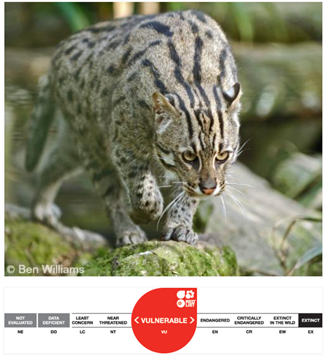

7th June 2022 (6 Topics)
Context
The Chilika Development Authority (CDA) recently informed that there are 176 fishing cats in Odisha’s Chilika Lake.
About
About the census:
- The Census was conducted in Collaboration with The Fishing Cat Project (TFCP).
- This is the world’s first population estimation of the fishing cat, which has been conducted outside the protected area network.
- Spatially Explicit Capture Recapture (SECR) method was used to analyze the data.
- The census by The Fishing Cat project was conducted in two phases.
- In 2021, for the first phase, surveyors focused on the 115 sq. km marshland in the north and north eastern section of Chilika Lake.
- The second phase of the fishing cat survey conducted in 2022 on the Parikud Side along the coastal part.
About the Fishing Cat:
- The fishing cat is a globally threatened species found in marshlands, mangroves, flooded forests and other wetlands.
- They are found in 10 Asian countries but have remained untraced in Vietnam and Java for more than a decade.
- Wetlands are the favorite habitats of the fishing cat.
- In India, fishing cats are mainly found in the mangrove forests of the Sundarbans, on the foothills of the Himalayas along the Ganga and Brahmaputra river valleys and in the Western Ghats.
- West Bengal declared the fishing cat to be its state animal in 2012.
- Authorities in Chilika also named the cat as the lake's ambassador in 2020.
- Protection Status:
- IUCN Red List: Vulnerable. Despite multiple threats, the Fishing Cat was recently downlisted to “Vulnerable” from “Endangered” in the IUCN Red List species assessment.
- CITES: Appendix II
- Indian Wildlife Protection Act, 1972: Schedule I
- The fishing cat is nocturnal and apart from fish also preys on frogs, crustaceans, snakes, birds, and scavenges on carcasses of larger animals.

Fishing Cat range Map:
Importance:
- The fishing cat, a Schedule I species according to the Wildlife (Protection) Act, 1972, generally indicates the health of wetland and coastal ecosystems, which are considered as one of the major safeguards against climate change.
- Fishing cats are the apex predator in coastal areas.
- If they survive, it means the area is climate-resistant.

